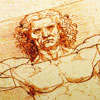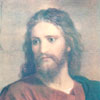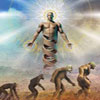The Reformation ~ The Liberation of Man
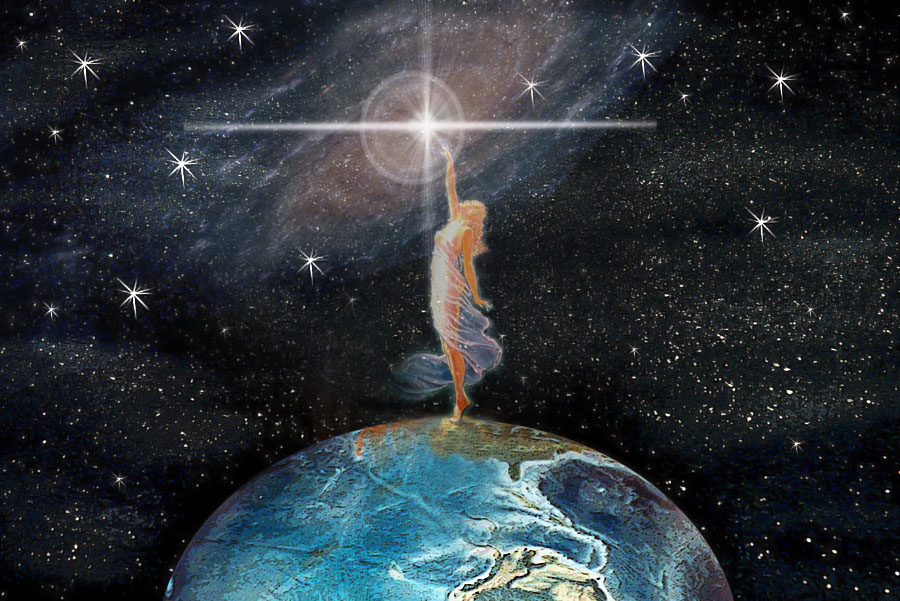
by Ernest L. Norman
Early Development of the Christian Church
…into the time of the advent of Christ, we find that there had been some new developments on the religious or 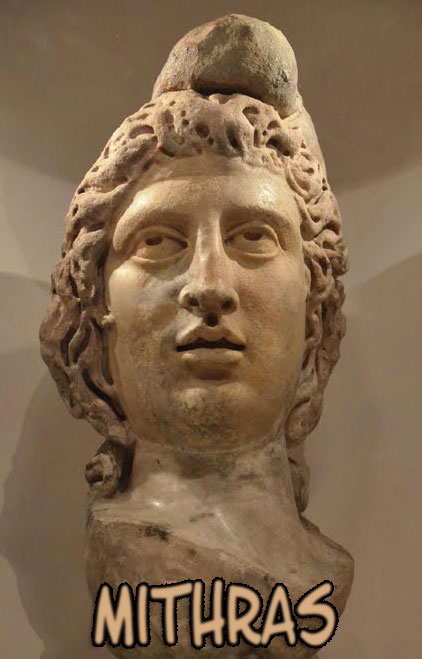 esoterical fields throughout the Mediterranean countries, particularly in Greece. One of these cults was called Mithraism, which was a direct outgrowth of the Zoroastrian concept, which had been expounded in Persia with the advent of the prophet Zoroaster. Mithraism was very attractive, inasmuch as it offered a large amount of pomp and circumstance, various observances and ceremonies, all of which were quite attractive to the people of that time. Other orders included the rabbinical orders of the Essenes, which stemmed from the more ancient Hebraic concepts from the Holy Land. We also find at that time a large group which was growing out of some of the lighter orders of Christian concepts, known as the Gnostics, who were spiritually minded people who believed that the true wisdom and knowledge and interpretations of life stemmed directly from the inward consciousness of man.
esoterical fields throughout the Mediterranean countries, particularly in Greece. One of these cults was called Mithraism, which was a direct outgrowth of the Zoroastrian concept, which had been expounded in Persia with the advent of the prophet Zoroaster. Mithraism was very attractive, inasmuch as it offered a large amount of pomp and circumstance, various observances and ceremonies, all of which were quite attractive to the people of that time. Other orders included the rabbinical orders of the Essenes, which stemmed from the more ancient Hebraic concepts from the Holy Land. We also find at that time a large group which was growing out of some of the lighter orders of Christian concepts, known as the Gnostics, who were spiritually minded people who believed that the true wisdom and knowledge and interpretations of life stemmed directly from the inward consciousness of man.
Beginning somewhere about twenty or thirty years after the time of Jesus, we find Paul in Greece very busily at 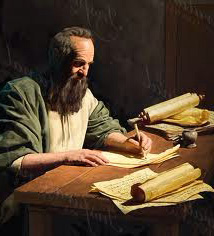 work. It had been some time since his conversion on the road to Damascus; and he had already lived some time in Corinth and written some of his very famous letters to the people of that city. These letters and teachings exist in the modern translations of the New Testament. Paul, as you know, was formerly anti-Christ and persecuted the Christians to the utmost of his ability until his conversion. It was Paul who started the first Christian church; and as Paul was also a very clever businessman in his own way, he realized that religion, just as anything else, should be attractive and should present certain aspects to the convert; consequently, he contrived to weave the concepts of Mithraism into his own Christian church.
work. It had been some time since his conversion on the road to Damascus; and he had already lived some time in Corinth and written some of his very famous letters to the people of that city. These letters and teachings exist in the modern translations of the New Testament. Paul, as you know, was formerly anti-Christ and persecuted the Christians to the utmost of his ability until his conversion. It was Paul who started the first Christian church; and as Paul was also a very clever businessman in his own way, he realized that religion, just as anything else, should be attractive and should present certain aspects to the convert; consequently, he contrived to weave the concepts of Mithraism into his own Christian church.
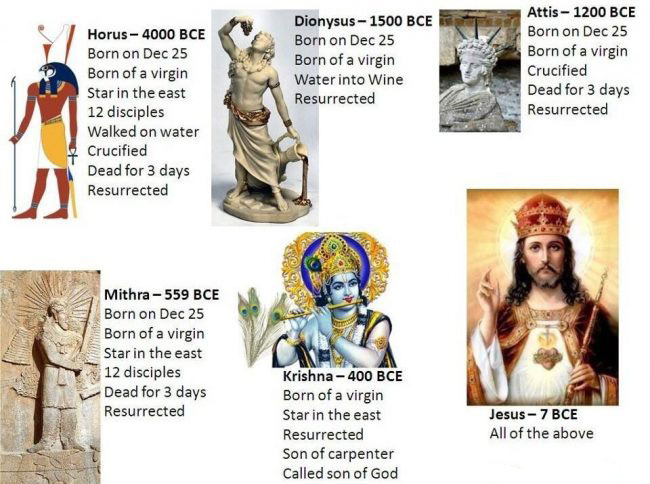 The winter solstice of December the twenty-first to the twenty-fifth of that month was a time of religious observances, climaxed by indulgences on the twenty-fifth. This later became the birthday of the Christ; and the story of the immaculate conception, just as it existed with the concept of Zoroaster, was here interwoven into the Christian philosophies of the origin of the Christian religion. With the death of Paul, the Christian church split into two factions – the one faction remaining in Greece as a Greek Orthodox, which later developed into the Byzantine Empire. The other which was under direct supervision of Peter, with headquarters in Rome, became later known as the Holy Catholic Church or, as it was called in those days, the Christian Church.
The winter solstice of December the twenty-first to the twenty-fifth of that month was a time of religious observances, climaxed by indulgences on the twenty-fifth. This later became the birthday of the Christ; and the story of the immaculate conception, just as it existed with the concept of Zoroaster, was here interwoven into the Christian philosophies of the origin of the Christian religion. With the death of Paul, the Christian church split into two factions – the one faction remaining in Greece as a Greek Orthodox, which later developed into the Byzantine Empire. The other which was under direct supervision of Peter, with headquarters in Rome, became later known as the Holy Catholic Church or, as it was called in those days, the Christian Church.
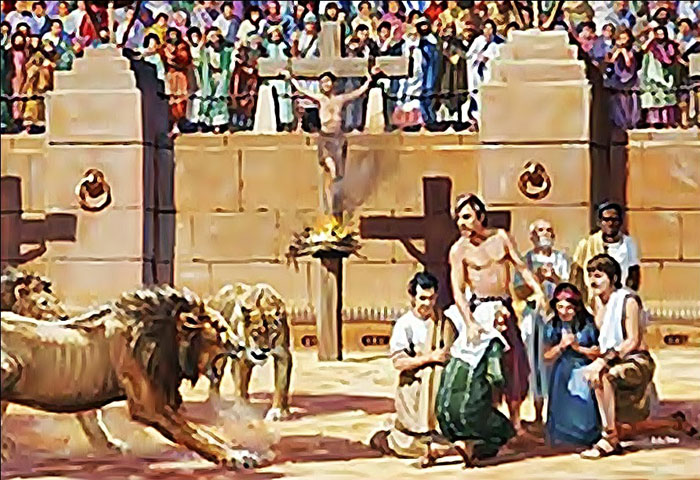 So for over 200 years, this church, under the supervision of those who followed after Peter, suffered severe persecutions from the Romans. The Christians were fed to the lions and were burned at the stake and suffered other innumerable martyrdoms, until the advent of the Emperor Constantine, who became converted to Christianity and issued the Milan Edict, which not only made Christianity lawful and legal, but placed it under the direct protectorate of the Roman Emperor himself. Funds were donated to build churches and otherwise to promote the growth of the Christian Church.
So for over 200 years, this church, under the supervision of those who followed after Peter, suffered severe persecutions from the Romans. The Christians were fed to the lions and were burned at the stake and suffered other innumerable martyrdoms, until the advent of the Emperor Constantine, who became converted to Christianity and issued the Milan Edict, which not only made Christianity lawful and legal, but placed it under the direct protectorate of the Roman Emperor himself. Funds were donated to build churches and otherwise to promote the growth of the Christian Church.
The Holy Roman Empire
Thus entered a phase of history known as the Holy Roman Empire; and thus under the numerous Roman Emperors who came up during the hundreds of years following Constantine, it was a question whether the later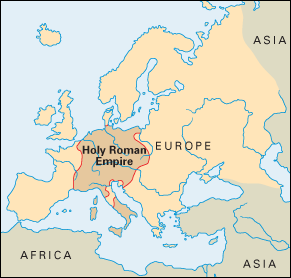 version of the Roman Catholic Church, which began to be head by an individual known as the Pope, or whether the Emperor of Rome himself ruled the Roman Church. As it was known, the Holy Roman Empire came into such strength and dominion that it overran and overruled the entire western continent of Europe; and by the time of Otto the First, in the year 800 A.D., it was completely and thoroughly entrenched in all countries. At about the time of the twelfth and the thirteenth centuries, this Holy Roman Empire had gathered such strength that it ruled the destinies of the small and the great. Kings and queens trembled at the Pope’s name, and no one dared act unless he knew that it would be thoroughly approved by the visionaries in Rome. The Pope literally held the keys to heaven and hell for every individual.
version of the Roman Catholic Church, which began to be head by an individual known as the Pope, or whether the Emperor of Rome himself ruled the Roman Church. As it was known, the Holy Roman Empire came into such strength and dominion that it overran and overruled the entire western continent of Europe; and by the time of Otto the First, in the year 800 A.D., it was completely and thoroughly entrenched in all countries. At about the time of the twelfth and the thirteenth centuries, this Holy Roman Empire had gathered such strength that it ruled the destinies of the small and the great. Kings and queens trembled at the Pope’s name, and no one dared act unless he knew that it would be thoroughly approved by the visionaries in Rome. The Pope literally held the keys to heaven and hell for every individual.
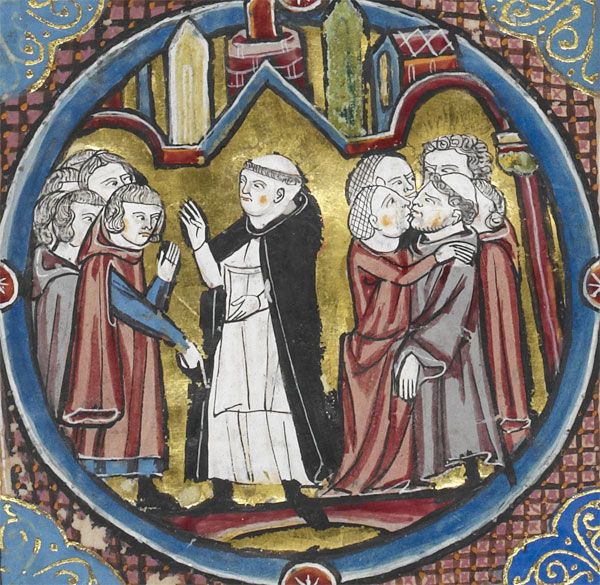 Confession was mandatory at regular intervals. It was so, too, that the various ecclesiastical orders were also in great preponderance and abundance. Fat monks waddled up and down the highways and byways and streets of every country in Europe; nuns, too, from the various cloistered convents were numerous and made their appearance in countless and divers places. It was so that the individual who worked for his living, a tradesman or yeoman, was subjected to various tithes or taxations, which reduced him to even a lower existence or level; so that gradually the wealth of these countries of Europe was being absorbed into coffers of the church.
Confession was mandatory at regular intervals. It was so, too, that the various ecclesiastical orders were also in great preponderance and abundance. Fat monks waddled up and down the highways and byways and streets of every country in Europe; nuns, too, from the various cloistered convents were numerous and made their appearance in countless and divers places. It was so that the individual who worked for his living, a tradesman or yeoman, was subjected to various tithes or taxations, which reduced him to even a lower existence or level; so that gradually the wealth of these countries of Europe was being absorbed into coffers of the church.
The Reformation
Now it is so conceived that such tyranny and such oppression must be relieved. The ultimate destiny of mankind is not to be long overridden or overburdened by such tyrannical oppression. The very soul of man himself will, under such pressure, scream to the high heavens for relief. Thus it was that the great Shamballa, headed by the planet Eros, swung into action; and for the next five or six hundred years, the planet earth was at different times literally showered with the illustrious names of many thousands of individuals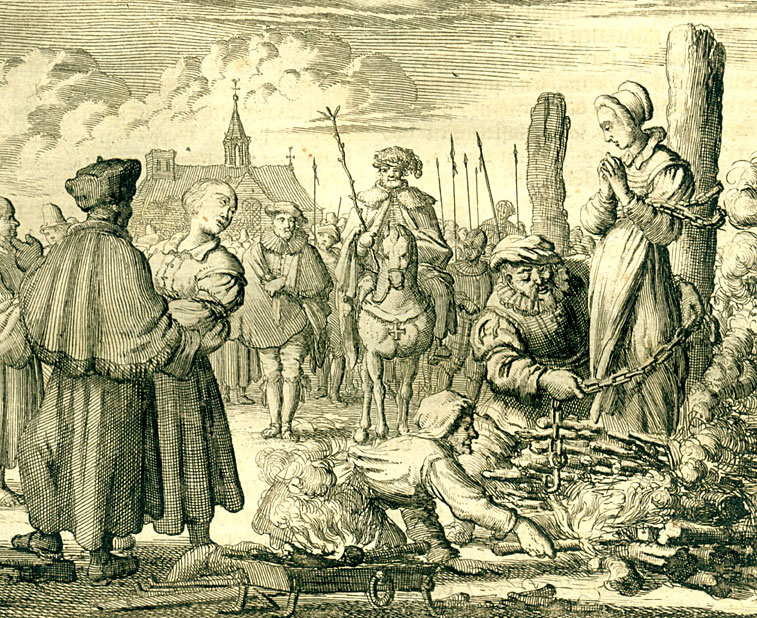 , who each contributed in a large and small part to the liberation of mankind from the tyranny of the Holy Roman Empire. This was the period known as the Reformation; and is also known as the Inquisition, with the writhing and squirming of the minds of men for liberation as came the writhings and squirmings of the Papal orders which took all manner of means to suppress any outbreaks. Consequently, in the coming several hundred years and in my time, we saw literally hundreds of thousands of people burned at the stake; others were thrown into dungeons or broken upon the rack or the wheel, or excommunicated and sent into exile. Sometimes their businesses and fortunes were confiscated and their families and homes broken and sent into disgrace. These periods of inquisition were written as some of the blackest blotches upon the pages of history. I might also say that some of the brightest pages of history are lying side by side with the black ones, written with the words and signed by the names of these illustrious personages who incarnated into your earth at that time.
, who each contributed in a large and small part to the liberation of mankind from the tyranny of the Holy Roman Empire. This was the period known as the Reformation; and is also known as the Inquisition, with the writhing and squirming of the minds of men for liberation as came the writhings and squirmings of the Papal orders which took all manner of means to suppress any outbreaks. Consequently, in the coming several hundred years and in my time, we saw literally hundreds of thousands of people burned at the stake; others were thrown into dungeons or broken upon the rack or the wheel, or excommunicated and sent into exile. Sometimes their businesses and fortunes were confiscated and their families and homes broken and sent into disgrace. These periods of inquisition were written as some of the blackest blotches upon the pages of history. I might also say that some of the brightest pages of history are lying side by side with the black ones, written with the words and signed by the names of these illustrious personages who incarnated into your earth at that time.
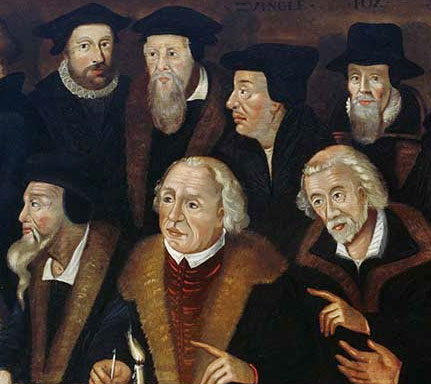 I could name a few of these very luminous minds, starting with Francis Bacon, in the field of literary expressions; and around and about his time came others, such as Wycliffe, and a Scotsman by the name of John Knox. Then everyone knows of Martin Luther and his holy insurrection against the Holy Roman Empire. There were others, too who manifested a great deal of influence; John and Charles Wesley, who started the religious order known as Methodism; William Penn, who migrated with his converts and followers to America, in seeking his religious freedom. In fact, the Thirteen Colonies were originally founded by such religious refugees as the Puritans, who sought religious sanctuary in the far-off land across the sea, away from the oppressive dominion of the Catholic Church or the Church of England.
I could name a few of these very luminous minds, starting with Francis Bacon, in the field of literary expressions; and around and about his time came others, such as Wycliffe, and a Scotsman by the name of John Knox. Then everyone knows of Martin Luther and his holy insurrection against the Holy Roman Empire. There were others, too who manifested a great deal of influence; John and Charles Wesley, who started the religious order known as Methodism; William Penn, who migrated with his converts and followers to America, in seeking his religious freedom. In fact, the Thirteen Colonies were originally founded by such religious refugees as the Puritans, who sought religious sanctuary in the far-off land across the sea, away from the oppressive dominion of the Catholic Church or the Church of England.
There were other expressions, too, which illuminated and typified the struggle for the rise of mental and spiritual stature and nature of man at that time. In the poetry of that time, we find such great masters as Goethe, 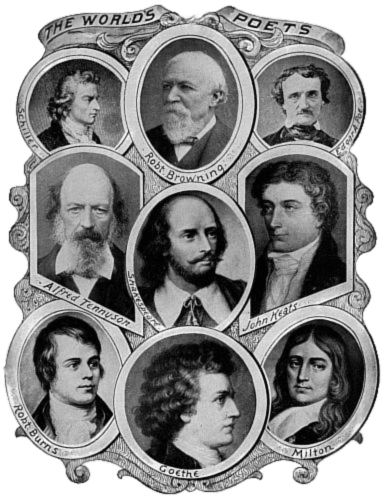 Chaucer, Browning, Tennyson, Gray, Keats, all of these men and many more, and shall I say women also, referring to Elizabeth, who lent a small voice; and although they did not outwardly castigate or exorcise the Roman Empire and its Holy Church, yet their works were no less conducive to the liberation of the consciousness of man into a higher trend of spiritual concept. For myself, I (Anton van Leeuwenhoek) fortunately contributed something to the world of science, and as a former draper, I was interested in lenses; and in the magnifications of the first crude lenses which I ground, and so contrived the first model of my first microscope, which was simply a pinhole drilled through a piece of brass whereon a tiny droplet of water was suspended. Peering through this tiny hole at some object immediately below, the drop of water gave some sort of distorted magnification. Later on I developed a way to grind lenses and mount them in the turret heads of an instrument, which was the forerunner of your modern microscope; and I managed to achieve magnifications which enabled me to inspect some of the microscopic domain, called bacteria, protozoans, cells, and various other types of heretofore unseen and unknown structures in the world about us.
Chaucer, Browning, Tennyson, Gray, Keats, all of these men and many more, and shall I say women also, referring to Elizabeth, who lent a small voice; and although they did not outwardly castigate or exorcise the Roman Empire and its Holy Church, yet their works were no less conducive to the liberation of the consciousness of man into a higher trend of spiritual concept. For myself, I (Anton van Leeuwenhoek) fortunately contributed something to the world of science, and as a former draper, I was interested in lenses; and in the magnifications of the first crude lenses which I ground, and so contrived the first model of my first microscope, which was simply a pinhole drilled through a piece of brass whereon a tiny droplet of water was suspended. Peering through this tiny hole at some object immediately below, the drop of water gave some sort of distorted magnification. Later on I developed a way to grind lenses and mount them in the turret heads of an instrument, which was the forerunner of your modern microscope; and I managed to achieve magnifications which enabled me to inspect some of the microscopic domain, called bacteria, protozoans, cells, and various other types of heretofore unseen and unknown structures in the world about us.
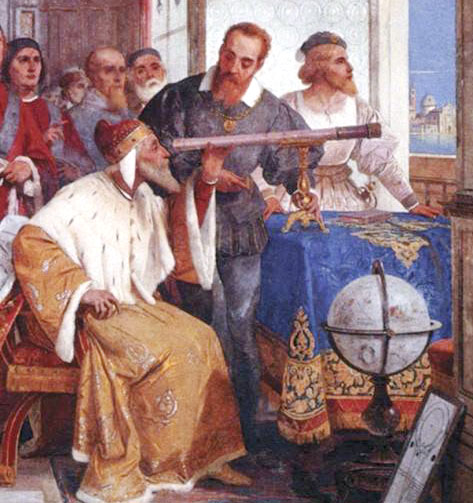 Far to the south of me in the sunny land of Italy was my dear friend Galileo, who brought into expression the first usable refractory telescope; and thus he explored the heavens to verify further the findings of Copernicus, who placed the earth in its proper orbit around the sun and thereby explored the immediate reaches of the great celestial and terrestrial universe about us. Incidentally, I might say that Galileo found in his small telescope that there were something like 300 or 400 million suns or stars, which the modern astronomers have been able to catalogue. It is at this present time estimated that these various stars or suns in the terrestrial universe number over a hundred trillion. However, do not pay too much attention to these astronomical figures; a trillion or a billion means little to the average person. In some future day when you have elevated into a concept of truth and light, you will be able to see a much larger portion, not only of the terrestrial, but also of the celestial universe.
Far to the south of me in the sunny land of Italy was my dear friend Galileo, who brought into expression the first usable refractory telescope; and thus he explored the heavens to verify further the findings of Copernicus, who placed the earth in its proper orbit around the sun and thereby explored the immediate reaches of the great celestial and terrestrial universe about us. Incidentally, I might say that Galileo found in his small telescope that there were something like 300 or 400 million suns or stars, which the modern astronomers have been able to catalogue. It is at this present time estimated that these various stars or suns in the terrestrial universe number over a hundred trillion. However, do not pay too much attention to these astronomical figures; a trillion or a billion means little to the average person. In some future day when you have elevated into a concept of truth and light, you will be able to see a much larger portion, not only of the terrestrial, but also of the celestial universe.
Excerpt from The Voice of Hermes
See Part II here.
Posted in Book Excerpts, True History of Man, Voice of Hermeswith comments disabled.


